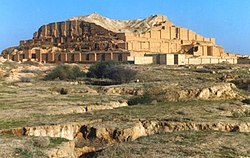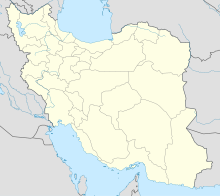Chogha Zanbil
| Chogha Zanbil | |
|---|---|
|
UNESCO world heritage |
|

|
|
|
Ziggurat in Chogha Zanbil |
|
| National territory: |
|
| Type: | Culture |
| Criteria : | (iii) (iv) |
| Reference No .: | 113 |
| UNESCO region : | Asia and Pacific |
| History of enrollment | |
| Enrollment: | 1979 ( session 3 ) |
Coordinates: 32 ° 0 ′ 30 ″ N , 48 ° 31 ′ 15 ″ E
Chogha Zanbil ( Persian چغا زنبيل, DMG Coga Zanbil [ tʃoˌγɔː zæmbiːl ], antique major Untasch ) is a medium- Elamite royal residence built by King Untasch-Napirischa (Untasch-GAL) (1275-1240 v. Chr.), Son of Humban- Numena founded was. The city is located about 40 km southeast of Susa (Shush) in the Khuzestan province of today's Iran . Like other oriental rulers of the same time, Untash-Napirischa also left the old capital of his country to found a new city. The city is perhaps based on the model of Dur-Kurigalzu . Around 640 BC Dur-Untasch was conquered by the troops of the Assyrian king Ashurbanipal . The city was, however, until the end of the Elamite era in the 6th century BC. Settled. Today the ruins are recognized as a UNESCO World Heritage Site.
Surname
The name Chogha Zanbil means "basket hill". Other spellings of the name are Chogha Zanbil , Tsoga Zambil and Tchoga Zanbil .
topography
The city is about 100 hectares and surrounded by a wall.
temple
In the middle is a walled temple area, the centerpiece of which is a ziggurat that is still 25 m high (originally around 50 m high) , which is one of the best-preserved temple towers in Mesopotamia. It has a side length of 105 m and is the oldest ziggurat found in Elam to date. It consisted of a high temple on four terraces and was dedicated to Napirischa and Inschuschinak . The ziggurat was built over a flat temple of the Inschuschinak, which was filled with mud bricks. Access was not via outside stairs, as in Mesopotamia, but via stairs inside. The temple was probably clad with glazed bricks, the upper floors decorated with glazed pommel bricks (clay nails). Half-life-size clay figures of bulls and griffins were found on the temple portals. On the back of the bull figure is an inscription to Inschuschinak. In the vicinity of the ziggurat there were pedestals and smaller, ground-level temples that contained votive offerings . A processional street led towards them, which was paved with fragments of brick.
In the vicinity of the ziggurat were three other temples, one of which was dedicated to the goddess Kiririsha . Other temples were in the Temenos area. Outside the Temenos only one temple was built south of the palaces. It was dedicated to the god Nusku . Ghirshman sees it as a forerunner of the Persian fire temples , since the central room was not covered.
Palaces
In the north-east of the city there were four palaces, which were structured around central courtyards and presumably follow Kassite models. The facades were decorated with colored relief tiles. Ivory inlays were probably part of precious furniture.
In the southernmost palace there were five underground tombs. Few remains of burials have been found.
Water supply

Since the Dez river, which is located next to the city, is deeply cut into the terrain and the water table is more than 50 meters deep, the water had to be drawn from the Karche river near Susa via a 50 km long canal . The canal was built by Untash-Napirischa . It passed the Haft Tepe and ended in a large reservoir that is still visible today in front of the north-western city wall. In connection with other subsequent smaller basins, this had the task of treating the water before it was fed into the fine distribution of the city. The structure, which is over 3000 years old, is considered the oldest water treatment plant in the world.
Research history
Chogha Zanbil was discovered by airborne geologists around 1935 searching for oil in the area. Excavations by French teams under Roman Ghirshman took place mainly in 1936, 1939 and 1951 to 1962. From 1999 to 2005 further archaeological investigations were carried out under the direction of Behzad Mofidi-Nasrabadi as part of a UNESCO project in Chogha Zanbil.
Important finds
- half-life-size clay figures of bulls and griffins
- numerous frit seals in notch cut style
- female figure made of frit from the Temple of Pinikir
- silver votive ax from the Temple of Pinikir, decorated with a lion's head and a boar
literature
- P. Amiet: Elam. 1966
- Barthel Hrouda: Near East. Munich 1971
- Roman Ghirshman: Tchoga Zanbil (Dur-Untash) (= Mémoires de la Délégation Archeologique en Iran 39-42). Paris 1966-70
- DT Potts: The Archeology of Elam. Cambridge 1999, ISBN 0-521-56496-4 , pp. 222-230
- M. Roaf: Mesopotamia. Image Atlas of Cultures. Munich 1998, ISBN 3-86047-796-X , p. 143
- Heidemarie Koch: Women and Snakes, Mysterious Culture of the Elamers in Old Iran , Verlag Zabern 2007, pp. 129–152, ISBN 978-3-8053-3737-3
- Heyda Seyed-Ashraf: Elam - an old culture in Iran , Books on Demand, Norderstedt 2008, ISBN 978-3-8334-7336-4
Web links
- Chogha-Zanbil Travel Guide and Tours
- Entry on the UNESCO World Heritage Center website ( English and French ).
Individual evidence
- ↑ UNESCO World Heritage Center: Tchogha Zanbil. Retrieved September 23, 2017 (English).



